 Written by Hulet Smith, OT
Written by Hulet Smith, OT
As occupational therapists, we’ve noticed that when given the choice between getting around on crutches or a knee scooter, people recovering from a foot or ankle injury overwhelmingly prefer using a knee scooter. This rolling device allows you to rest the lower part of the leg on the knee pad, keeping your foot elevated and not bearing any weight.
It takes a lot of upper body strength to get around on crutches, and if an arm injury is involved, it’s physically impossible. Before knee scooters came onto the scene, people who couldn’t manage crutches had to use a wheelchair while healing, which can be very limiting. Knee scooters, sometimes referred to as knee walkers, require much less exertion to get around than crutches and are preferred by almost 90 percent of patients studied.
A knee scooter lessens the chance of reinjury from putting weight on the foot or suffering a fall while trying to balance on crutches. Knee scooters also free up your hands and allow you to get on with daily activities while healing.
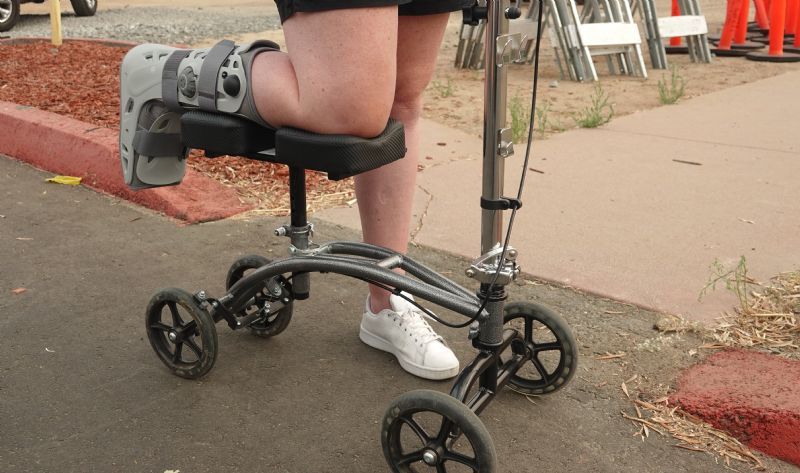
A knee scooter, or knee walker, is a rolling mobility device with two to five wheels, a cushioned knee rest platform, and handlebars. We know it’s a comfortable alternative to crutches for keeping weight off an ankle or foot injury while it heals and keeping your hands free for daily activities. By resting your leg on the knee pad and self-propelling with the opposite foot, you can roll wherever you want to go, maintaining your independence and ability to accomplish daily tasks while your injury heals.
A large majority of patients, when given the choice, will choose a knee scooter over crutches. Crutches are less expensive than knee scooters, but bring with them challenges for people who have balance issues, do a lot of walking, and like to spend time outdoors. Plus, we understand crutches can be painful, or at the very least, much less comfortable than a knee scooter.
Most knee scooters fold with the simple release of levers located along the knee scooter frame.
Boots are not compatible with most knee scooters. However, with new two-pad knee scooter designs on the market, more options are becoming available. A boot works best with a knee scooter that features a two-pad design with a gap between the two knee rest pads.
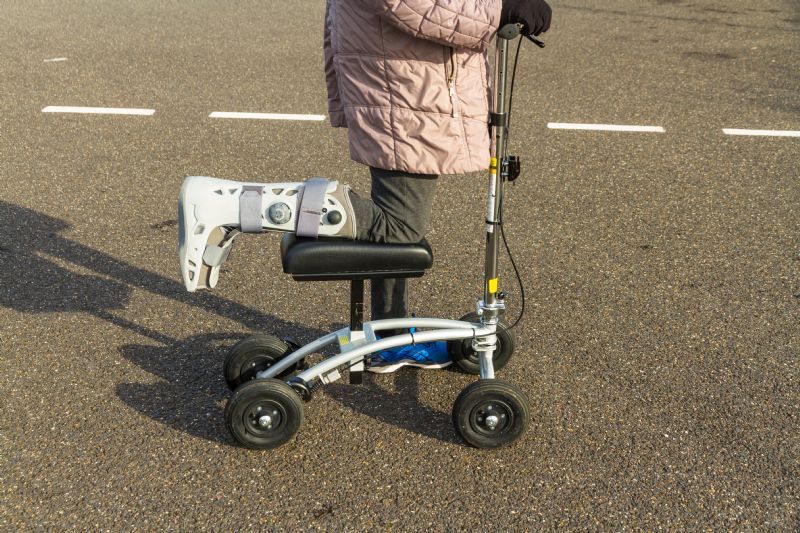
All knee scooters provide enhanced mobility and share common design elements of wheels, handlebars, and padded knee rest. Options and features to consider when choosing the best knee walker to fit your needs are maneuverability, weight capacity, knee rest design, portability, brake system, accessories, and whether it is suitable for indoor or outdoor use.
In our experience, steerable knee walkers offer the most maneuverability with directional control provided by handlebars. They are the most popular designs and can get you into the most places with the least amount of effort. However, it is possible to take a turn too sharply or too quickly, which can cause the knee scooter to tip. Front wheels on steerable versions can be pulled off course if they encounter an obstacle or an uneven surface, so if balance is a concern, a fixed steering model might be preferable.
Using a knee scooter that can’t support your weight risks further injury, so it’s important to get a good fit on a durable frame. Most standard scooters can accommodate users up to about 300 pounds. Since frame materials vary, we urge you to consider the sturdiness and composition of the frame. This is especially important if you have a larger frame yourself. Since the knee scooter will be supporting almost your entire body weight, it needs to be able to support you safely.
The size and shape of the knee rest as well as what it’s made from all contribute to your comfort when using a knee scooter. Economy models are attractive because they are less expensive, but their knee rests usually have the least amount of padding and attention to ergonomics. We suggest that if you will be using a knee walker for any length of time, it’s best to choose one that has substantial padding and is designed to truly cradle your lower leg.
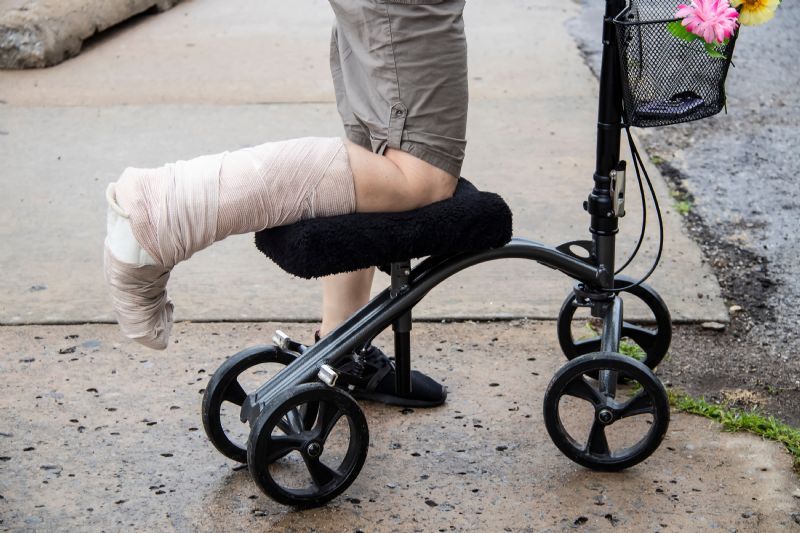
If one of the reasons you want a knee scooter is to maintain your ability to go where you want to go, consider what it takes to get the scooter where you want to be. Most models are foldable, usually using a lever on the handlebars or near the knee rest. Models that are compact and lightweight are easier to transport and manage folding and unfolding, which is especially important if you’re going to be on your own.
There are two types of hand brakes on knee scooters. Drum brakes, like what you would see on a bicycle, and loop brakes, which are great for fast braking. Some models have the brakes fixed on one side of the handlebars, some can be assembled with the brake on the right or the left side, and some have hand brakes on both sides. In our experience, knee scooters with locking wheel brakes have an additional layer of safety and convenience to keep from rolling while getting on or off.
One of the best things about a knee walker is that it leaves your hands free to grab things. Once you have those things, it’s nice to have a place to put them while you’re rolling, so most knee scooters come standard with either bags or baskets. We love these carry-alls, and they come in different sizes and shapes depending on your needs. Since bags need to be kept clean on the inside, they require a little more attention than open baskets, but both are great options.
Getting outdoors is proven to speed healing and improve overall health. Any knee scooter can be used indoors, but there are some special features to look for if you’re spending a lot of time on one outside. Four-wheeled models are preferable to the three-wheeled versions for outdoor use, and steering capability is a must. We believe heavy-duty knobby tires are a solid choice for outdoor use so that you get good traction on wet ground and reduce the chance of slipping or getting the wheels stuck.
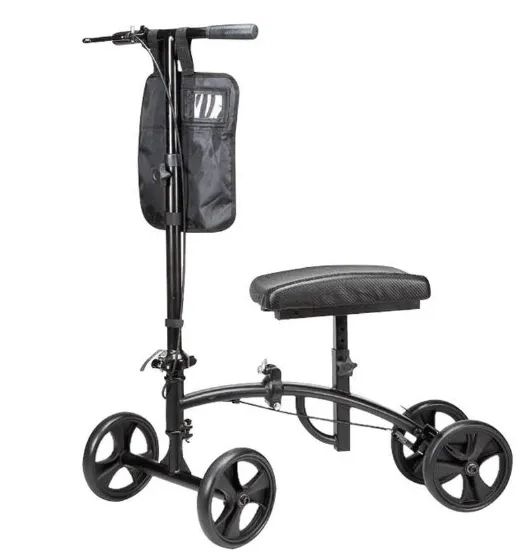
The Steerable Knee Scooter Medical Walker enters our list at number 5. It can accommodate users up to 300 pounds and the handlebar height and knee rest height are both adjustable. The hand brake can be positioned on the right or left side and it has a large pouch for the hands-free transport of personal items. It is built on a compact foldable steel frame, and with four 8-inch durable wheels, it can be used outdoors.
Made by Cardinal Health, this knee walker is a solid base model without a lot of extras and is a great choice if you have some difficulty with balance or walking, but only need a minimum amount of support.
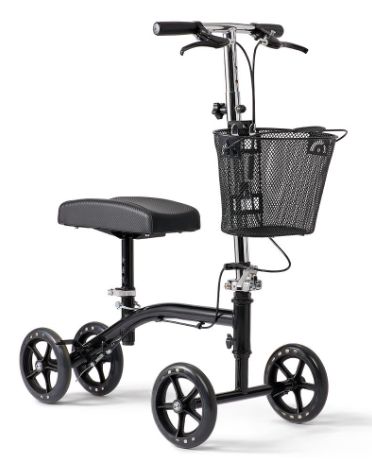
On the list at number 4 is the Generation 4 Basic 4-Wheeled Walking Knee Scooter by Medline. It has a universal knee rest to support the right or left leg and can accommodate users up to 300 pounds. The full-length leg cushion has extra padding for added comfort.
It has locking hand brakes on both sides of the ergonomic handlebars. It has a large storage basket. Among the top picks on this list, this model is the easiest to adjust for comfort and good posture.
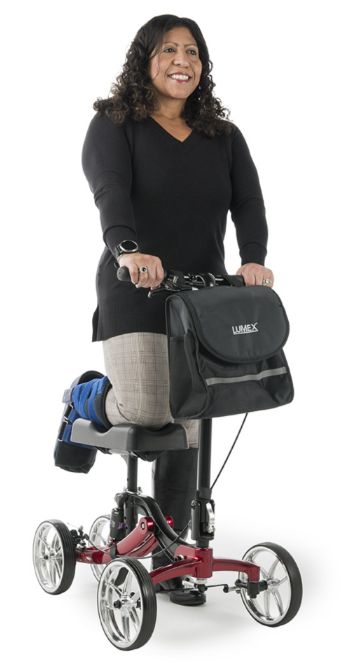
Third on our list is the Graham-Field Lumex Knee Walker by Lumex. Despite its compact size, this knee walker boasts a durable aluminum frame that can support a maximum weight capacity of 300 pounds. This ensures that users can rely on the walker for safety and stability throughout their recovery journey.
Equipped with large 8-inch non-marking polyurethane casters, this walker offers maneuverability both indoors and outdoors. The easy-to-use handles further enhance maneuverability by enabling safe turning in tight spaces. Additionally, the handgrip braking system allows for quick or extended stops, ensuring the user's safety at all times. The built-in shock absorber is a notable safety feature, as it ensures a smooth and secure ride by absorbing shock impulses from uneven pavements. This Lumex walker is available in three color options - black, apple red, or purple.
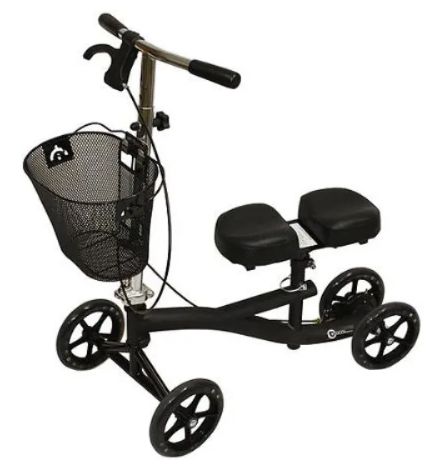
Number two on our list is the Knee Scooter Rollator Walker with Padded Knee Platform by Roscoe Medical. The handles fold down without tools and it’s lightweight and easy to carry. The parking brake provides extra safety and control. This knee walker comes with a generously sized wire basket, and its four large wheels make it safe for indoor and outdoor use.
It meets a variety of user needs, from being especially easy to adjust to being highly maneuverable. It is suitable for people up to 300 pounds.
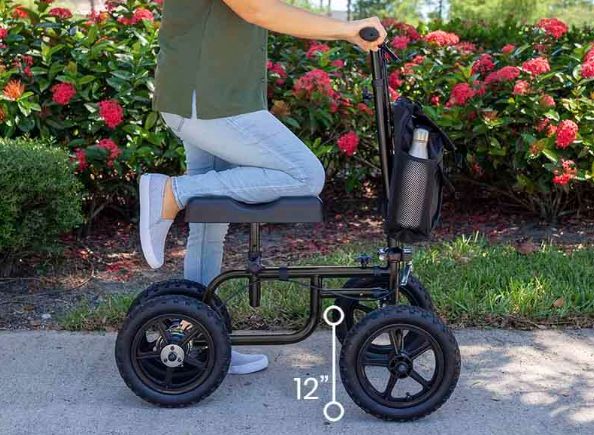
Making number one on our list was no small feat! If you’re looking for a knee walker that can take you over gravel, grass, or any other rough surface, the All-Terrain Knee Walker Scooter by Vive Health is a good option. This beefy knee scooter has four big 12-inch all-terrain tires for stability and traction that can navigate over any surface.
It comes with a large removable bag for conveniently holding personal items and this scooter’s folding frame makes it easy to transport and store. It is the first to make our list with an ergonomic knee rest specifically designed to contour to the leg. This feature relieves abrasions and irritation at pressure points that can cause the skin to break down over time. With a weight limit of 300 pounds, this knee scooter features a dual braking system and comes with handlebars and a knee platform that are easily adjusted for correct body positioning.
This is the most rugged option on the list and is a great choice for anyone who needs a knee scooter that’s built tough and can withstand a lot of time spent outdoors.
Several considerations go into the purchasing decision for a knee scooter. Questions of how long it will be used, where it will be used, the importance of portability, and the pad design all play a role in deciding on the best option.
The combination of maneuverability, comfort, safety, ease of use, and versatility all come together in our top overall choice of knee scooter. But any of these mobility aids, depending on what the most important features are for you, is a solid choice to promote healing and make the recovery period more productive, comfortable, and bearable. For more expert-driven buying guides, top 5 lists, or general information, please head over to Caregiver University!

Co-founder/CEO of Rehabmart, Pediatric Occupational Therapist, husband, and father. Passionate about connecting special needs kids with superb nutrition, sensory integration, and complementary health strategies. Excited about Rehabmart's mission to become the premier online educational platform which empowers caregivers by spotlighting innovative devices and interventions to achieve optimal patient response and recovery.